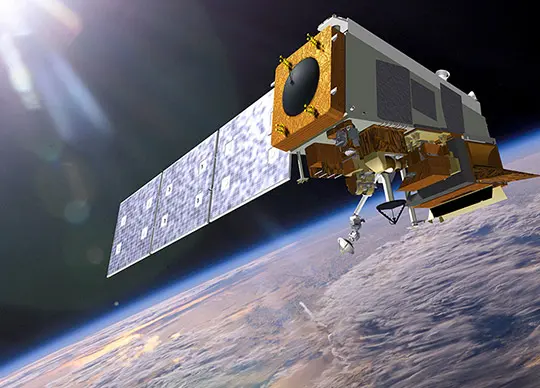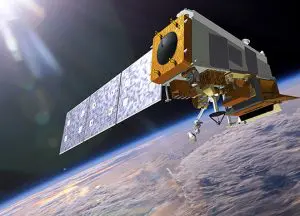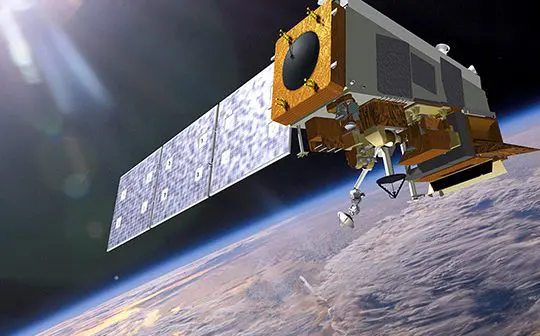

Image: The Joint Polar Satellite System (JPSS) is a new generation polar-orbiting operational environmental satellite system. JPSS is a collaborative program between the National Oceanic and Atmospheric Administration (NOAA) and NASA. JPSS-2 is NOAA’s next-generation operational Earth observation program that acquires and distributes global environmental data primarily from multiple polar-orbiting satellites.
NASA will provide coverage of the upcoming prelaunch and launch activities for the National Oceanic and Atmospheric Administration’s (NOAA) Joint Polar Satellite System-2 (JPSS-2) mission. JPSS-2 is the third satellite in the polar satellite series and is expected to capture data to improve weather forecasts, helping scientists predict and prepare for extreme weather events and climate change.
JPSS-2 is scheduled to launch at 5:25 a.m. EDT (2:25 a.m. PDT) Tuesday, Nov. 1, on a United Launch Alliance (ULA) Atlas V 401 rocket from Space Launch Complex 3 at Vandenberg Space Force Base in California.
Live launch coverage will begin at 4:45 a.m. EDT (1:45 a.m. PDT) on NASA Television, the NASA app, and the agency’s website, with prelaunch and science briefings beginning Friday, Oct. 28. Watch coverage on the agency’s website at: https://www.nasa.gov/live
JPSS represents significant technological and scientific advancements in observations used for severe weather prediction and environmental monitoring. These data are critical to the timeliness and accuracy of forecasts three to seven days in advance of a severe weather event. It will scan Earth as it orbits from the North Pole to the South Pole, crossing the equator 14 times a day to provide full global coverage twice a day.
NASA and NOAA partner in the development, launch, testing, and operation of all satellites in the JPSS series.
Launching with JPSS-2 is NASA’s Low-Earth Orbit Flight Test of an Inflatable Decelerator (LOFTID) technology demonstration. After JPSS-2 safely reaches orbit, LOFTID will follow a re-entry trajectory from low-Earth orbit to demonstrate the inflatable heat shield’s ability to slow down and survive re-entry. LOFTID is a partnership with ULA and is dedicated to the memory of Bernard Kutter, one of the company’s engineers who played a key role in developing the technology. LOFTID will demonstrate how the inflatable aeroshell, or heat shield, can slow down and survive re-entry in conditions relevant to many potential applications, whether landing humans on Mars, new missions to Venus and Titan, or returning heavier payloads and samples from low-Earth orbit.
Full mission coverage is as follows:
Friday, Oct. 28
6 p.m. EDT (3 p.m. PDT) – JPSS-2 Prelaunch News Conference on NASA TV with the following participants:
- Tim Walsh, director, NOAA’s JPSS Program Office, NOAA
- John Gagosian, director, NASA’s Joint Agency Satellite Division
- Irene Parker, deputy assistant administrator, NOAA Systems, National Environmental Satellite, Data, and Services
- Omar Baez, launch director, NASA’s Launch Services Program
- Gary Wentz, vice president, Government and Commercial Programs, ULA
- Jim Reuter, associate administrator for NASA’s Space Technology Mission Directorate
- Capt. Zack Zounes, launch weather officer, U.S. Space Force
Saturday, Oct. 29
- 4 p.m. EDT (1 p.m. PDT) – JPSS-2 Science Briefing on NASA TV with the following participants:
- Jordan Gerth, meteorologist and satellite scientist, NOAA’s National Weather Service
- Jim Gleason, senior project scientist, NASA JPSS, NASA
- Satya Kalluri, program scientist, NOAA JPSS Program
- Heather Kilcoyne, ground project manager, NOAA JPSS
- Joe Del Corso, LOFTID project manager, NASA’s Langley Research Center in Hampton, Virginia
Tuesday, Nov. 1
12 a.m. EDT (9 p.m. PDT Monday, Oct. 31) – NASA Edge will host the JPSS-2 Tower Rollback Show that will air live on NASA TV and YouTube.
NASA TV Launch Coverage
NASA TV live coverage will begin at 4:45 a.m. EDT (1:45 a.m. PDT) Tuesday, Nov. 1. For NASA TV downlink information, schedules, and links to streaming video, visit: http://www.nasa.gov/live
Audio only of the news conferences and launch coverage will be carried on the NASA “V” circuits, which may be accessed by dialing 321-867-1220, -1240, or 7135. On launch day, “mission audio,” countdown activities without NASA TV launch commentary, will be carried on 321-867-7135. A “tech feed” of the launch without NASA TV commentary will be carried on the NASA TV media channel.
Follow countdown coverage on the JPSS-2 launch blog at: https://blogs.nasa.gov/jpss-2/
Public Participation
Members of the public can register to attend the JPSS-2 launch virtually. The virtual guest program for this mission includes curated launch resources, notifications about related opportunities or changes, and a stamp for the virtual guest passport following a successful launch.
JPSS-2 Virtual Social
As we finalize launch preparations, we are excited to invite the public to join our virtual social media event hosted on Facebook.com/NASA beginning Wednesday, Oct. 26. Stay up to date on the latest mission activities, interact with NASA, NOAA, and other team members in real-time, and watch the launch of the ULA Atlas V rocket that will boost JPSS-2 for its journey into orbit.





